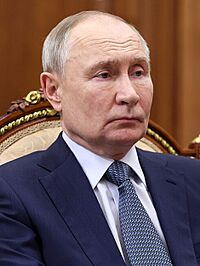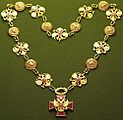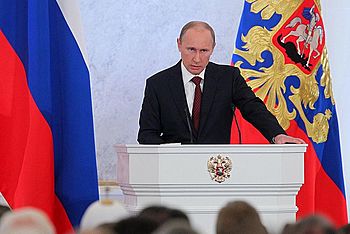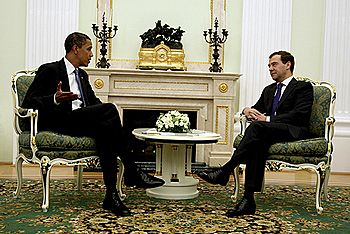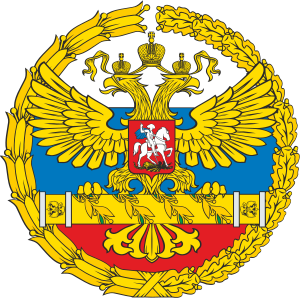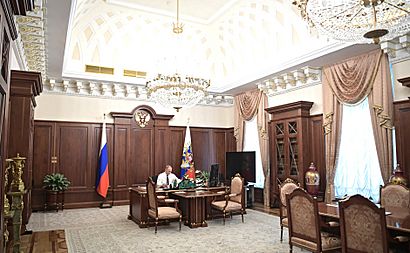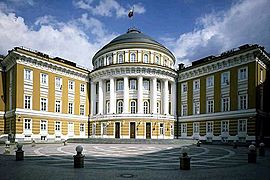President of Russia facts for kids
Quick facts for kids President of the Russian Federation |
|
|---|---|
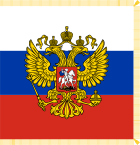
|
|
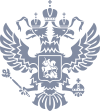
Presidential emblem
|
|
| Presidential Administration of Russia | |
| Style | Mr President (informal) Comrade Supreme Commander (military) His Excellency (diplomatic) |
| Member of |
|
| Residence |
|
| Seat | Kremlin Senate |
| Appointer | Direct popular vote |
| Term length | Six years,
renewable once
|
| Constituting instrument | Constitution of Russia (1993) |
| Precursor | President of the Soviet Union |
| Formation |
|
| First holder | Boris Yeltsin |
| Deputy | Prime Minister |
| Salary | 8,900,000₽ or US$120,000 per annum est. |
| Website | президент.рф (in Russian) eng.kremlin.ru (in English) |
The President of Russia is the top leader and head of state for Russia. This important role means the president is in charge of the country's executive branch. They also lead the Federal State Council and are the supreme commander-in-chief of the Russian Armed Forces. It's the highest position in Russia.
The idea for this job came from the president of the Russian Soviet Federative Socialist Republic (RSFSR). In 1991, Boris Yeltsin was chosen as the first president of the RSFSR. He was the first person not from the Communist Party to be elected to a big Soviet political job. He played a key part in the dissolution of the Soviet Union, which changed the RSFSR into the Russian Federation. After some challenges, a new constitution was put in place in 1993. This Russian Constitution is still used today. It makes Russia a semi-presidential system, which means the president and the government share executive power.
If the President of Russia cannot do their job, the prime minister of Russia temporarily takes over. They become the acting president of Russia until a new president is in office.
The president has many important duties. They make sure federal laws are followed. They also choose federal ministers and judges. The president works with other countries to make agreements. They can also grant pardons and call or end meetings of the Federal Assembly in special situations. The president also picks the prime minister, who helps lead Russia's domestic policies.
The president is chosen by a direct vote from the people for a six-year term. In the past, a president could only serve two terms in a row. But, changes made to the constitution in 2020 removed this limit. Now, a president can serve two full terms, even if they served before. So far, three people have been president, serving a total of six full terms. Vladimir Putin became president for the fourth time in May 2012. He was re-elected in March 2018 and again in March 2024 for two more six-year terms.
Contents
History of the Presidency
After the February Revolution in 1917, when the monarchy ended, there were plans for a democratic republic. The Russian Constituent Assembly wanted to create a presidential or semi-presidential federal republic in January 1918. The president would have been the head of state, elected for one year. However, the assembly was dissolved, and no one was ever elected to this role.
Boris Yeltsin became a leader before the Soviet Union broke apart. In May 1990, he was chosen as the head of the Supreme Soviet (parliament) of the Russian Soviet Federative Socialist Republic (SFSR). This made him the head of state. After the position of President of the Soviet Union was created, other parts of the Soviet Union also started to have presidents. A vote was held in the Russian SFSR, and 71% of people voted to create the position of president, elected directly by the people. On 12 June 1991, Yeltsin was elected president of the Russian SFSR with 57% of the votes. He was the first president chosen by popular vote.
During his time as president, Vladimir Putin became very popular with the Russian people. The Russian economy grew a lot, and average salaries increased. Dmitry Medvedev was appointed as a top official in 2005. He was also the chairman of Gazprom, a large energy company. In 2007, he was supported by the main political party, United Russia, to run for president. Vladimir Putin also supported him. Medvedev chose Putin as his prime minister. In 2012, Putin ran for president again, won, and then appointed Medvedev as prime minister.
How a President is Chosen
Who Can Be President?
To become president, a person must be a citizen of Russia. They must be at least 35 years old. They also need to have lived in Russia for at least 25 years. A candidate cannot have, or have ever had, foreign citizenship or a foreign residence permit. These rules were updated in 2020.
The Russian constitution says a president can serve a maximum of two terms. Before 2020, a president could serve two terms in a row, then take a break, and run again. But now, after the 2020 changes, it's a total of two terms, allowing current and former presidents to serve two more terms.
The Election Process
The Federation Council officially announces when presidential elections will happen. If they don't, the Central Election Commission will. Election day is always the second Sunday of the month. The entire country of Russia is the voting area for the president.
Each political group in the State Duma, which is the lower house of the Russian parliament, can suggest a candidate for president. If a political party does not have members in parliament, their candidate needs to collect 100,000 signatures to run. This number used to be 2 million, but it was changed.
The president is elected every six years using a two-round system. This means if no candidate wins more than half the votes in the first round, a second round is held. The second round is between the two candidates who received the most votes. The last presidential election was in 2024, and the next one will be in 2030.
Starting the Job: Inauguration

The president officially starts their job six years after the last inauguration, usually on May 7th. If a president is chosen in an early election, they take their oath 30 days after the results are announced.
Before starting their duties, the president must take an oath. This oath promises to protect the rights and freedoms of people, follow the Constitution, and serve the people of Russia.
I swear in exercising the powers of the President of the Russian Federation to respect and safeguard the rights and freedoms of man and citizen, to observe and protect the Constitution of the Russian Federation, to protect the sovereignty and independence, security and integrity of the State, to faithfully serve the people.
When the President Can't Serve
If the president dies, resigns, or is removed from office, their duties are temporarily given to the prime minister. The prime minister acts as president until a new president is elected and takes office.
Presidential Symbols
After the president takes their oath, they receive special symbols of their office. These are used to show their important position on special occasions.
Chain of Office
One symbol is a special chain with an emblem. The main part of the emblem is a red cross with the Russian coat of arms in the middle. Around the cross, it says "Benefit, Honor and Glory." The chain has 17 links, some with the Russian coat of arms and others with a rosette that also says "Benefit, Honor and Glory." This chain is kept in the Kremlin and is used only for certain events.
Presidential Flag (Standard)
The standard is a square version of the Russian flag. It has the Russian coat of arms in the center and golden fringe around the edges. Copies of this flag are used in the president's office, at the Kremlin, and when the president travels in a vehicle within Russia. A different version is used when the president is at sea. This flag is the most common way to show that the Russian President is present.
Special Constitution Copy
The president also has a special copy of the Russian Constitution. This copy is used during the inauguration ceremony. It has a hard, red cover with gold writing and a silver image of the Russian coat of arms. This special copy is kept in the Presidential Library.
Presidential Fanfare
The Presidential Fanfare is a special piece of music played only when the President of Russia enters a place or an event.
President's Powers and Duties
Protecting the Constitution
The president makes sure that the Constitution and all laws of Russia are followed. They also ensure that the laws of different regions within Russia match the country's main Constitution and federal laws.
Choosing Officials
The president plays a big role in choosing top officials. They suggest people for important government jobs, who then need to be approved by parliament. The president suggests judges for the Constitutional Court and the Supreme Court, as well as the prosecutor general. The president also suggests who should lead the Central Bank to the State Duma, the lower house of parliament.
Making Laws
The president can suggest new laws. They also have the power to sign bills into law or to veto them, which means they can stop a bill from becoming a law.
The president can temporarily stop laws made by local governments if those laws go against the Constitution, federal laws, or international agreements. They can also stop laws that violate people's rights.
The president can also make their own rules, called decrees. These decrees must not go against existing laws or the Russian Constitution.
Other powers include calling elections for the State Duma, dissolving the State Duma in certain situations, and calling a referendum (a public vote on a specific issue).
Domestic Policy
The president helps set the main goals for Russia's domestic policy, working with the prime minister and the government. These goals are put into action by the president and the government. The president's views on domestic policy are shown in their decisions about new laws and in their speeches.
Each year, the president gives a speech to the Federal Assembly about the country's situation and its internal and external policies.
Foreign Policy
The president has many rights to manage Russia's foreign policy. They decide Russia's position in international matters, along with the prime minister and government. The president represents Russia in international relations, holds talks, and signs international agreements. They also appoint and recall Russia's representatives to other countries and international organizations.
Commander-in-Chief
The President of Russia is the "Supreme Commander-in-Chief" of the Russian Armed Forces. This means they have the final say over the military. The president gives military orders, sets defense policy, and chooses the top leaders of the Armed Forces.
The president can also order a general or partial call-up of the military. They can announce martial law (when the military takes control), oversee the war industry, and make military rules.
Ceremonial Duties
An important ceremonial role of the president is giving out state awards. These awards are the highest official recognition for people who have done great service to the country in areas like defense, science, culture, education, and public safety. The president can create new awards and presents them in official ceremonies.
Presidential Residences
The president's main office is in the Senate building within the Moscow Kremlin. The president also uses the Grand Kremlin Palace for official events and meetings.
Since 2000, the president's main home residence is Novo-Ogaryovo. It was planned that Vladimir Putin would continue to use it after his term ended, just as Gorki-9 was used by Boris Yeltsin after he retired.
The president also has several vacation homes outside of Moscow, including places in Tver Oblast, Saint Petersburg, Sochi, Karelia, and Novgorod Oblast.
Political Affiliation
No Russian president has been a member of a political party while in office. In 2012, Vladimir Putin said that while the constitution doesn't stop a president from being in a party, a president should be a leader who unites all political groups and citizens.
Presidential Transport
The Special Purpose Garage (SPG) provides transport services for the Russian president. This is a part of the Federal Protective Service.
- Limousines
- Aurus Senat – the main car
- Mercedes-Benz S600 Pullman Guard
- Escort cars
- Mercedes-Benz (including G-Class)
- Chevrolet
- Motorcycle Escort
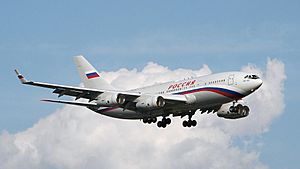
Air travel for the president is handled by Rossiya Airlines.
- Airplanes for long-distance travel
- Ilyushin Il-96-300PU (long-range) – main aircraft
- Ilyushin Il-62M (long-range)
- Dassault Falcon 900 (long-range)
- Tupolev Tu-154 (medium-range)
- Yakovlev Yak-40 (short-range)
- Tupolev Tu-214PU
- Helicopters
The president's aircraft look similar to regular Rossiya planes, but they have the Russian coat of arms or the presidential standard on the tail instead of the Russian flag.
In 2013, a helipad was built in the Moscow Kremlin. It cost about $6.4 million and is located in the Kremlin's Tainitsky Garden.
After Being President

Laws have been put in place to provide support for former presidents and their families. These laws ensure that former presidents receive certain benefits after their term ends.
- A former president receives a monthly payment for life. This payment is 75% of what the current President of Russia earns.
- If a president dies, their family members receive a monthly allowance.
- A former president has immunity. This means they cannot be charged with crimes or administrative offenses for things they did while they were president. They also cannot be arrested or questioned about these actions.
Since 1999, all living former presidents get a pension, an office, and staff. The pension has increased over time. Former presidents, their spouses, and children under 16 are protected by the Federal Protective Service for life. However, a spouse who remarries or divorces the president loses this protection.
In 2020, the Constitution was changed to give former presidents immunity, unless they were removed from office through a special process. This immunity can be removed in the same way. Also, former presidents (unless removed by impeachment) can become senators for life.
In May 2008, a law was passed about "centers of historical heritage of presidents." These centers are meant to study and share the history of Russian presidents. They help people learn about Russia's modern history and how democracy and law have developed. A center will be built for each former president. The first one, dedicated to Boris Yeltsin, opened in 2015 in Yekaterinburg. Plans are also in place for centers for Vladimir Putin and Dmitry Medvedev.
List of Presidents
| Name | Term of office | Length of term |
|---|---|---|
| Boris Yeltsin | 1991–1999 | 8 years, 5 days |
| Vladimir Putin (1st and 2nd terms) | 2000–2008 | 8 years, 0 days |
| Dmitry Medvedev | 2008–2012 | 4 years, 0 days |
| Vladimir Putin (3rd, 4th and 5th terms) | 2012–present | 13 years, 232 days |
Presidential Administrations
- Presidency of Boris Yeltsin
- Presidency of Vladimir Putin
- Presidency of Dmitry Medvedev
See also
 In Spanish: Presidente de Rusia para niños
In Spanish: Presidente de Rusia para niños
- List of presidents of Russia
- List of Russian presidential candidates
- List of heads of state of Russia
- Lifespan timeline of presidents of Russia
- First Lady of Russia
- Prime Minister of Russia
- President of the Soviet Union
- General Secretary of the Communist Party of the Soviet Union
- Russian presidential administration


